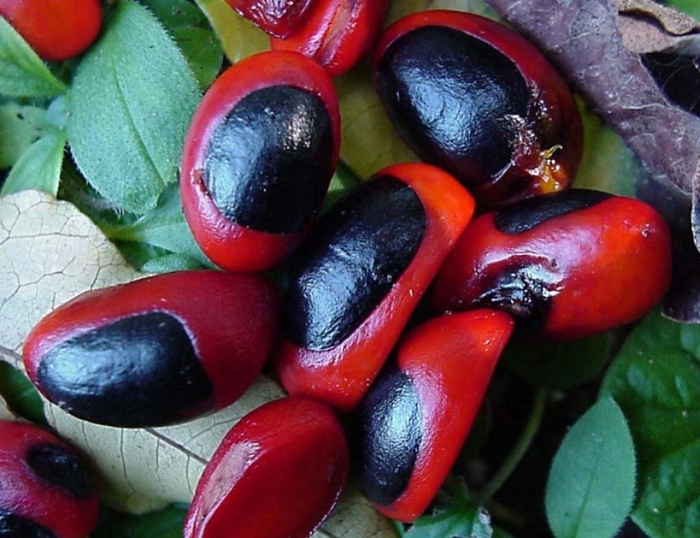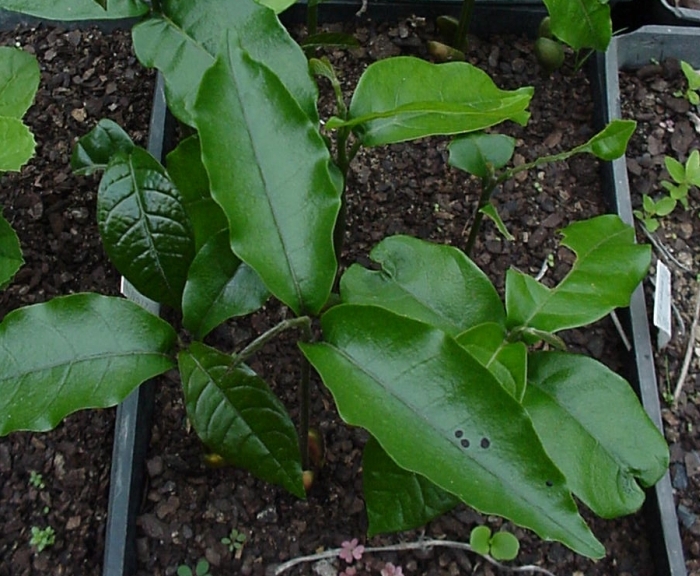Trichilia dregeana
Trichilia dregeana Sond.
Family: Meliaceae
Common names: forest mahogany, forest Natal-mahogany, Cape mahogany, thunder tree, Christmas bells, red ash (Eng.); rooiessenhout, bosrooiessenhout, basteressenhout (Afr.); umKhuhlu, uMathunzini (Zulu); umKhuhlu (Xhosa); mmaba (Northern Sotho); mutuhu, mutshikili (Venda).
SA Tree No: 300
Introduction
Trichilia dregeana is a lovely large tree that inhabits evergreen forests in high rainfall areas. It is a highly ornamental species with considerable cultural and ecological value to match.

Description
Description
A significant feature of the forest mahogany, particularly evident in those growing in open situations, is the beautiful dark foliage and large rounded crown. Impressive heights of up to 35 m have been recorded, the tall main stem assuming a relatively straight and sometimes buttressed habit, up to 1.8 m in diameter. The grey bark is smooth in texture, but often rough and segmented around the base of the main stem on older specimens.

The compound leaves can reach lengths of 70 cm and are imparipinnate with 3-5 pairs of leaflets and a terminal one, the petiole being 8-10 cm in length. The leaflets are entire, opposite to alternate, glossy and dark green in colour, and can attain a size of 21 cm in length and 8.5 cm in width. They exhibit 8-12 pairs of side veins, petiolules around 1 cm in length, and an undersurface that is hairless to slightly hairy and notably paler than above.

The creamy-white flowers, produced in early summer, from October to December, are borne in dense, branched axillary inflorescences, with petals that are velvety on both surfaces and 1.4 cm-2.4 cm in length.

The fruits are round, velvety capsules, 3 cm in diameter, that split usually into 3 valves. On splitting, the capsules reveal 6 very attractive seeds, these being black and covered largely by a bright red to scarlet aril, a striking and distinctive feature of the tree. Fruiting occurs mainly in late summer to autumn, between January and May.
The Natal mahogany, Trichilia emetica, is a tree that superficially resembles the forest mahogany. The two can however be readily distinguished from one another by observing some basic features. T. emetica produces leaflets containing 13-16 pairs of side veins, whereas only 8-12 are evident in T. dregeana, and those of the former are also less glossy and not as dark in colour, with an apex that is more rounded than the acute to acuminate tips seen in T. dregeana. In addition, the fruit capsules have a distinct neck joining them to their stalk, a feature absent in T. dregeana. Although the distribution ranges of the two species overlap in areas, T. dregeana is more commonly found in forest situations as opposed to the more open habitat of T. emetica.

Distribution and habitat
Distribution description
Trichilia is a relatively large genus of trees and shrubs occurring in Africa, America and Asia. The two tree species in South Africa belonging to the genus are T. dregeana and T. emetica. Characteristics of the genus include leaves that are imparipinnate and spirally arranged, unisexual flowers produced on the same tree in cymes or cymose panicles, the flowers being pentamerous (floral parts in 5s), and fruits that are 3-valved capsules.
T. dregeana is a fairly widespread species, stretching from Pondoland and KwaZulu-Natal in the south, through Swaziland, Mpumalanga and Limpopo provinces, into Zimbabwe and northwards into tropical Africa. It is found in areas of high rainfall in coastal and montane evergreen forest. Altitudes ranging from 15 m to 1220 m above sea level have been recorded (Germishuizen and Meyer 2003). Due to its ornamental attributes it is widely cultivated and as a result is often encountered outside of its natural habitat.
Derivation of name and historical aspects
History
According to Palmer and Pitman (1972), the generic name is derived from the Greek 'tricho' meaning 'in 3 parts', in reference to the fruits which often have 3 valves, while the species name 'dregeana' is in honour of Johan Franz Drege, a German collector who collected specimens of the forest mahogany in KwaZulu-Natal in the early 1800s. Palmer and Pitman (1972) also point to the interesting derivation of the vernacular name 'Umkomaas tree'. The name is based on the Zulu word for a female whale, the whales having suckled their young by the Umkomaas river mouth, an area containing many of the trees.
T. dregeana is a member of the family Meliaceae. This is a woody family of trees and shrubs with 51 genera comprising a total of approximately 575 species (Allaby 1998). Around 20 of these are native to the southern African region. The family occurs in the tropics and subtropics of the northern and southern hemispheres but is particularly well represented in the tropical regions of America and Asia. Features of the family include alternate, simple or pinnately compound leaves, flowers that are regular, bisexual or unisexual, with petals and sepals united at the base, and ovaries that are superior with 2-6 locules (Allaby 1998). The Meliaceae family is renowned for its timber trees which include the likes of Swietenia mahogani (West Indian mahogany), Khaya anthotheca (red mahogany), Khaya senegalensis (African mahogany), and Entandrophragma caudatum (mountain mahogany), as well as species of Trichilia(Pooley 1993). Lansium domesticum (Langsat) is a fruit popular in south-east Asia, while certain chemical compounds evident in the family have been found to have insecticidal properties (Van Wyk and Van Wyk 1997).
Ecology
Ecology
Flowers of Trichilia dregeana are visited by both bees and butterflies, and numerous birds are known to feed on the seed of the tree (Pooley 1993). Several butterfly species, including the white barred charaxes, have been observed breeding on the tree (Pooley 1993), and according to Von Breitenbach (1965) the aril of the seed is fed on by baboons. The timber is prone to attack by borer and it is therefore recommended that it be treated prior to use (Van Wyk and Van Wyk 1997). The tree also provides suitable nesting sites for a number of bird species.
Uses
Use
The range of uses and applications of T. dregeana is quite impressive. The wood is a pale pink, soft, evenly grained and easily worked, making it very suitable for carving (Van Wyk et al 2000). It is used for furniture and household implements, and in the 19th century was used to repair ships at Durban harbour in (the then) Natal (Pooley 1993). Once the seed coat has been removed the seeds are edible, and the seed arils are cooked as a vegetable or crushed to yield a milky juice taken as a drink or with side dishes (Van Wyk et al 2000). The seeds are also rich in fat, this fat being used in soaps, as a body ointment and hair oil, as well as for cooking (Von Breitenbach 1965). The species is also an important medicinal plant with the seed, oil, leaves, roots and bark being used for such purposes (Pooley 1993). Unspecified plant parts are used by the Zulus to treat stomach complaints and backache, and the Xhosa are known to administer bark decoctions as enemas for kidney-related backache; the Vhavenda also administer enemas produced from the bark for kidney problems and as stomach cleansers and blood cleansers. In Nigeria the leaves are used in the treatment of syphilis, and in Zimbabwe the bark is used as a purgative and as a fish poison (Hutchings et al 1996). Palmer and Pitman (1972) state that throughout Africa the tree is used to treat a range of ailments including leprosy and sleeplessness.
The forest mahogany, owing to its attractive nature and the fact that it makes an effective shade tree, is now a commonly cultivated species. Many fine specimens exist in the subtropical coastal city of Durban in the numerous parks and gardens, and it is one of the dominant street trees here having been planted extensively for this purpose. T. dregeana is now readily available from many South African plant nurseries in areas where the climate suits its growth.

Growing Trichilia dregeana
Grow
The forest mahogany is most commonly propagated from seed. Seed should be sown fresh as its capacity to germinate tends to decrease on drying. Sow in river sand or an equal parts mix of compost and river sand, and keep moist in a brightly-lit and well-ventilated area. Germination times vary from around 2-4 weeks, and seedlings are relatively fast-growing. Sowing can be carried out from spring to summer. The species is frost sensitive and is thus not recommended for very cold climates. Due to the substantial size which the species can attain, it is best suited to larger gardens. It will tolerate high or low light conditions, and is thus versatile in the garden setting, and due to its low light tolerance is becoming an increasingly popular house plant. It is a fine shade tree that casts a deep, cool shade but being evergreen should be carefully positioned if winter sun is desired in areas of the garden. Plant in a large, well-composted hole, roughly 1 cubic metre in size, and water regularly until established.
References
- ALLABY, M. 1998. A Dictionary of Plant Sciences. Oxford University Press, Oxford.
- GELDENHUYS, C.J. 1975. Raising Indigenous Trees . Department of Forestry, Pretoria.
- GERMISHUIZEN, G. & MEYER, N.L. 2003. Plants of southern Africa : an annotated checklist . National Botanical Institute, Pretoria.
- HUTCHINGS, A ET AL. 1996. Zulu Medicinal Plants : an Inventory. University of Natal Press, Scottsville.
- PALGRAVE, M. COATES & PALGRAVE, K.COATES. 2002. Trees of Southern Africa . Struik Publishers, Cape Town.
- PALMER, E. & PITMAN, N. 1972. Trees of Southern Africa (3 vols.). AA Balkema, Cape Town.
- POOLEY, E. 1993. The Complete Field Guide to Trees of Natal, Zululand and Transkei. Natal Flora Publications Trust, Durban.
- VAN WYK, B. & VAN WYK, P. 1997. Field Guide to Trees of Southern Africa . Struik Publishers, Cape Town.
- VAN WYK, B, VAN WYK, P & VAN WYK, B-E. 2000. Photographic Guide to Trees of Southern Africa. Briza, Pretoria.
- VENTER, F & VENTER, J-A. 2002. Making the Most of Indigenous Trees. Briza, Pretoria.
- VON BREITENBACH, F. 1965. The Indigenous Trees of Southern Africa. Department of Forestry, Pretoria.
Credits
Jan-Hakon Burring
Kirstenbosch National Botanical Garden
December 2004
Plant Attributes:
Plant Type: Tree
SA Distribution: KwaZulu-Natal, Limpopo, Mpumalanga
Soil type: Clay, Loam
Flowering season: Early Summer
PH: Alkaline, Neutral
Flower colour: White, Cream
Aspect: Full Sun, Shade
Gardening skill: Easy
Special Features:
Horticultural zones









Rate this article
Article well written and informative
Rate this plant
Is this an interesting plant?
Login to add your Comment
Back to topNot registered yet? Click here to register.